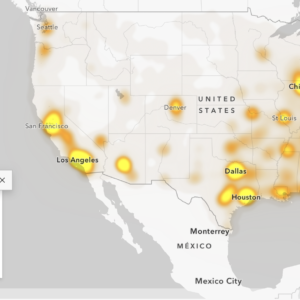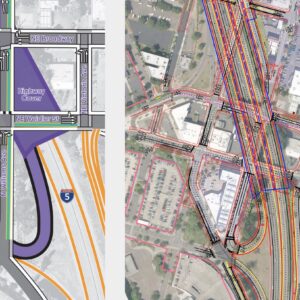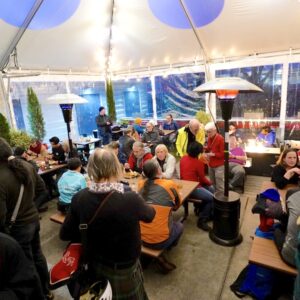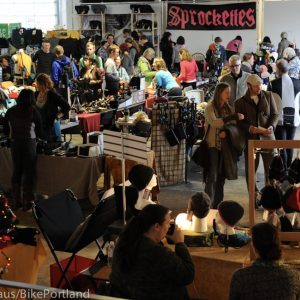Two state legislators’ announcement this week that $1.9 million from the state’s general fund would pay for new flashing beacons and traffic islands at 18 East Portland crosswalks communicated two things about Portland streets.
First: that street safety is one of State Rep. Shemia Fagan’s core issues, something she’s consistently putting political capital behind. Second: that rectangular rapid-flash beacons, which communicate a person’s desire to cross without using red lights to stop traffic completely, have become one of the city’s go-to safety tools.
Fagan’s list of crosswalks that will get the beacons is slightly different than the one Commissioner Steve Novick and advocacy group Oregon Walks were pushing last week. On Thursday, city staffer Gabriel Graff provided a list of the city’s tier 1 and tier 2 street-crossing improvements, with the 17 East Portland projects selected by Fagan and State Rep. Jessica Vega Pederson for funding marked in yellow.
The legislators also lined up money for an 18th location, the state-managed crossing of SE Powell at 168th.
Oregon Walks President Aaron Brown wrote in an email Wednesday that the advocacy group “is still pushing for some general fund money to get more crosswalks” but that he suspects Tuesday’s announcement makes city crosswalk spending less likely in the current budget cycle.
Our story about this issue last week drew some particularly interesting comments, many of them around the question of whether flashing beacons are a relatively low-cost safety improvement for deadly streets, or a half-measure that doesn’t solve the underlying problem of East Portland’s auto-oriented streets and development patterns.
Here’s a take from commenter GlowBoy:
While think Novick’s reasoning about “chasing down drug dealers who are just going to be replaced by other drug dealers” is faulty (you don’t avoid doing the dishes because you’re going to make more dirty dishes tomorrow), I think this would be a good start. Too many people are being killed by vehicles.
I’m impressed that aside from two spots in SW (which can also be hell for pedestrians), all of these proposed locations are east of 82nd.
From sbrock:
Was very happy when flashing beacons were install at University of Portland. The problem now is that a few people don’t activate them and now motorists are not as vigilant at scanning the area because they give a false sense of security now coupled with complacency now. Most people push the button. Just enough to give you the impression that the crosswalk is safe, then out comes the one or two, who for reasons unknown don’t activate the beacon. Have seen it many times now. If you don’t need reliance on the pedestrian I think it would be a safer system.
From Boris Kaganovich:
Expensive non-solution. Standard NACTO high-vis zebra crosswalks (of which we have none in Portland) could be painted at significantly more than 15 intersections for $1 million.
From pakikala, in reply:
Painting crossings without other features added is the non-safe solution. The PBOT standard is to include RRFB for every 5-lane crossing as a minimum standard, preferably with a median refuge island. Multi-lane crossings also need high level warnings with advance stop bars to reduce the double-threat issue. A single marked crossing on a 5-lane section, with a refuge island and the 3 poles (2 side, one center) starts off around ($3k+$15k+$36K) $54,000 and most people expect two crossings per intersection.
From Engineer Scotty:
The beacon thingies have, from the point of view of transportation engineers, two advantages over traditional signallized crosswalks:
* They are cheaper to install
* They are less disruptive to traffic.The second item is skewed priorities–unless there is enforcement of crosswalks, if drivers believe that stopping is optional (it isn’t, of course, but many are confused on this point), some of them won’t stop.
More active enforcement of beacon crosswalks–i.e. cops running stings and writing tickets (if the beacon is flashing, a motorist should not be able to avail himself of the “I didn’t see the pedestrian” or “I didn’t think he was in the crosswalk” excuses) is one step. But if that doesn’t go far enough…
…how about putting actual stoplights (or HAWK lights) mounted on poles? Ones that turn RED? In much of Europe, and in the nation’s capital, most traffic signals are mounted on poles on the side of the road; traffic lights hanging from wires or gantries over the lanes are relatively rare.
I invited Graff, the PBOT staffer, to respond to Scotty’s arguments that a HAWK light, also known as a half-signal or hybrid beacon, is often preferable to a flashing beacon. Graff confirmed the first point:
Hybrid signals (also known as HAWKs) are generally more expensive to install (starting at $150,000) than Rectangular Rapid Flash Beacons (RRFBs) but it depends on the street. We typically install hybrid signals in places where the ped/bike crossing demand is higher (e.g. 100 crossings an hour in the peak). As your commenters allude to, they function differently than RRFBs, providing a red indication that requires cars to stop even when there are no longer pedestrians or cyclists in the crossing.
Graff added that the city believes the flashing beacons ” will be sufficient for the crossing demand” at intersections with lower pedestrian volumes.
Correction 11:44 pm: An earlier version of this post said Mayor Charlie Hales attended Tuesday’s press conference. He did not.







Thanks for reading.
BikePortland has served this community with independent community journalism since 2005. We rely on subscriptions from readers like you to survive. Your financial support is vital in keeping this valuable resource alive and well.
Please subscribe today to strengthen and expand our work.
I have to say those lights do a pretty good job or grabbing your attention when you’re driving.
Too bad they are ugly.
Sure, all the other traffic control devices, electric boxes on corners and wires overhead are totally attractive.
They are more attractive than an ambulance …
Is there good proof that these improve safety overall? I would be concerned that drivers could be less likely to stop for pedestrians in cross-walks if the beacons were not operating, or at cross-walks without beacons.
The current crosswalk system is simply broken. Every intersection is a crosswalk, yet somehow this has maybe a 50% compliance rate on quieter streets and a 5% compliance rate on big busy streets. You’re also required to physically extend part of yourself into the street to prompt traffic to stop. Of course, even when you do that, the response from auto traffic is laughable.
We either need some drastic measures (education campaign, testing, lowering of speed limits) to fix compliance, or we should stop kidding ourselves and throw away the concept of every intersection being a crosswalk. A law with such pathetic real world compliance just further undermines the justice system. This can be said for speed limits and other traffic-related laws, but that’s an even bigger discussion…
To elaborate a bit more…
There are so many unmarked crosswalks that are woefully ineffective, that the idea of retrofitting these beacons everywhere is really absurd. It also further reinforces drivers’ misconception that the only thing that they should stop for on a big street is a light.
With regard to crosswalk compliance I would disagree…I have never been in a city anywhere in the world where automobiles are as respectable to pedestrians as in Portland. It is quite impressive.
I do not like these flashing beacons from either the pedestrian or driver point of view. They are a band-aid for poor design and just add another layer of traffic sign complexity.
I find myself agreeing that this city is better than anywhere else I’ve been in the US, but I also think the bar is set pretty low. On narrow two lane roads, I have pretty good luck at crossing unmarked crosswalks. It’s by no means the equivalent of a red light though; it can take anywhere from 1 sec to 30 sec of standing there waiting. Once you hit a wide two lane road width (essentially a 4 lane with no street parking) it becomes a lottery. Even downtown trying to cross SW Jefferson to get to the Art Museum, I was standing in the road “pump faking” trying to get cars to stop. Drivers stared right at me and kept driving. From a ROW perspective, it’s no different than running a red light in front of cross traffic with a green light. If you compare stopping for peds relative to stopping for red lights are you still impressed?
Wait, there’s a jingle in there. “Stop for a ped like you stop for a red”
Your welcome world!
I’ve always wondered how well these work. Is there data that supports they make it safer? I’ve seen cars blow through them on Barber (anecdotal evidence I know).
the yellow flashing beacons do not require motorists to stop. They are an aid to pedestrians to alert motorists of a desire to cross. Hybrid Beacons have a solid red phase, followed by a flashing red phase. Motorist must stop and stay stopped on solid red, but can stop, then go on flashing red if the crosswalk is clear.
Which is why they suck. We have one on a trail out here in the DC area and they just confuse everyone concerned.
Can we get one at Terwilliger and Canyon? There is a staircase that descends from the VA right there and it is absolute hell trying to cross Terwilliger. The road curves and drivers, even if they’re only traveling at the speed limit, don’t have much time to react. A signal would be visible from farther away.
The following link will take you to some research conducted by Portland State University titled: A Study on Driver’s Compliance to Rectangular Rapid Flashing Beacons [RRFBs]. http://web.cecs.pdx.edu/~monserec/courses/safety/project/2013/Group%201%20-%20FinalReport.pdf
There was a subsequent report by the PSU Team that was peer reviewed in advance of the Transportation Research Board meeting in January of this year. The report cites data for yielding without activation of the beacon and increases when the beacon is active. https://wiki.cecs.pdx.edu/pub/ItsWeb/TrbConferences/14-2893_DriverPedBehaviorAtCrosswalks.pdf
This research is nearly consistent with what the City has collected at SE 80th & Foster and the beacon installed on SE 82nd in 2010.
Kudos to Chris Monsere at Portland State for encouraging students to take up some basic research that truly informs practitioners of the effectiveness of these devices and of course to the students who do the difficult work of data collection and analysis!
Graff also offered these studies of beacon effectiveness, not based on behavior in Portland:
http://www.fhwa.dot.gov/publications/research/safety/pedbike/10046/
http://katana.hsrc.unc.edu/cms/downloads/FDOT_BA784%20EvaluationRectangularRapidFlashBeaconStPetersburgFlorida.pdf
Both found that the percent of cars that yield to people crossing increases dramatically with after these beacons are installed, especially on streets where people hardly ever yielded for crosswalks before. Both also found that the yielding rate is still well below 100 percent.
Gift? Really?
Not really a grant, as I understand it. Got a better short word?
contribution?
I’ve been experimenting on when to hit the REQUEST button.
Having better luck by waiting for a break in traffic congestion. That way I get a longer look at oncoming vehicles and hopefully they get a longer look at me.
It seems like when 3 lanes are stopped for you, the view of and by that fourth lane gets blocked (to poor result)
I use the crosswalk pictured in the article almost everyday (bottom of the hill coming onto Swan Island). The problem at this intersection is speed. It honestly feels like I’m going to cause a pile-up if I push that button. A lot of people ride a couple hundred yards up the road to use the next crosswalk just for that reason. I think speed enforcement is needed, at least occasionally.
The City prefers yellow lights that some people stop at versus red blinking lights that are more effective and safer? Vision Zero is pretty clear- use the red blinky light to actually stop cars!
Like Brendan a couple comments above, I use the Swan Island crosswalk/RRFB. I hit the beacon, and it seems to make more drivers notice and stop for the crosswalk.
Speed is an issue, or more generally, “being in a hurry”. I make sure that no car hastily changes lanes into the left while a truck is stopped in the right before proceeding through.
Despite the hassle that the stop must cause heavy commercial vehicles, my experience is that the semi truck drivers really do stop for every RRFB activation that they can safely stop for.
the one on Se 122nd (just south of Powell) confuses a lot of drivers. It was installed with no usage directions or signs. People don’t know when to start again.
the flashing yellow beacon on Stark ( 126th ?) is frequently flashing with nobody around. Drivers are learning to ignore that one (and how many others ?)
for some reason the one at the Midland Library is NOT straight through on the island. Must be that way to slow down bikes as they have to make a funny zigzag to get across it.
I’m not relating to the comments about poor compliance with these beacons. I frequently pass by the ones on Barbur, and the ones on Beaverton-Hillsdale near the city limit, both while I’m driving and while I’m biking.
While it’s true that cars don’t always stop for the beacons, it’s also true that they’re not required to. Often a car comes across a flashing beacon after the pedestrian has finished crossing, or is several lanes away.I haven’t see a car fail to stop when there was actually a pedestrian crossing.